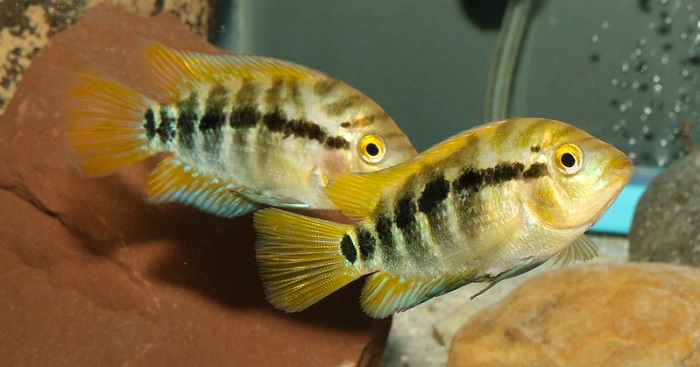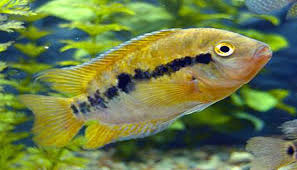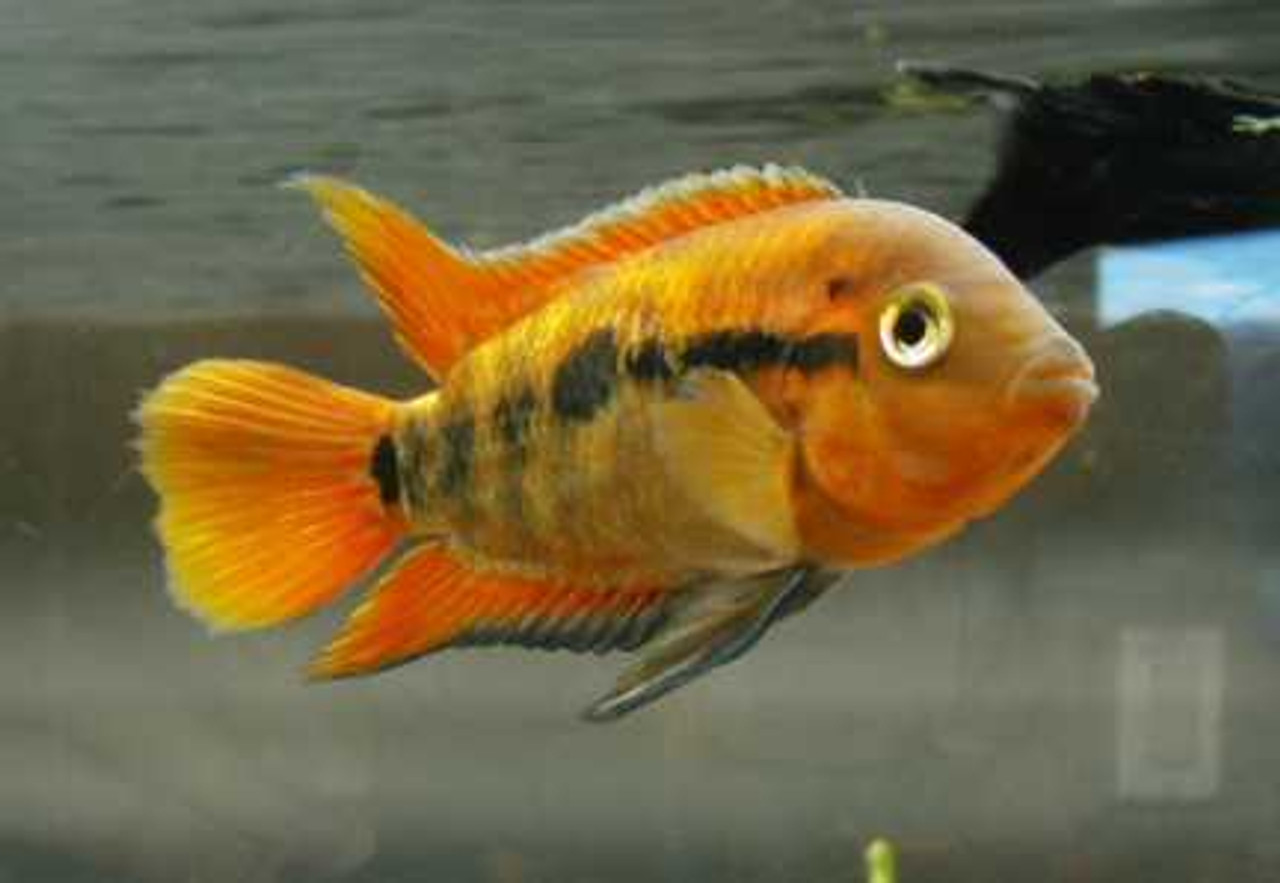Rainbow Cichlid

A Splash of Colour: The Ultimate Guide to Caring for the Vibrant Rainbow Cichlid
The Rainbow Cichlid (Herotilapia multispinosa), a gem of the freshwater aquarium hobby, is a captivating fish that brings a dazzling display of colour and engaging personality to any tank. Despite their cichlid lineage, often associated with aggressive behaviour, these Central American natives are surprisingly peaceful, making them an excellent choice for community aquariums when housed with appropriate tank mates. This in-depth guide will explore everything you need to know to provide the best possible care for your Rainbow Cichlids, ensuring they thrive and showcase their full, spectacular colouration.
From Central American Waters to Your Aquarium: The Natural Habitat of the Rainbow Cichlid
Native to the slow-moving rivers, streams, and coastal lagoons of Costa Rica, Honduras, and Nicaragua, the Rainbow Cichlid is accustomed to warm, slightly alkaline waters. These environments are typically rich in vegetation, with sandy or muddy substrates littered with fallen leaves, branches, and rocks, providing ample hiding places and foraging opportunities. Understanding their natural habitat is key to creating an aquarium environment that mimics these conditions, promoting natural behaviours and overall well-being.
Setting the Stage: Tank Requirements for a Thriving Rainbow Cichlid

Creating the ideal aquatic home is the first and most crucial step in caring for your Rainbow Cichlid. A well-structured environment will not only keep your fish healthy but also allow their stunning colours to truly shine.
Tank Size: A minimum of a 75-litre (20-gallon) aquarium is recommended for a single Rainbow Cichlid. For a pair, a 110-litre (30-gallon) tank is preferable to provide adequate space, especially during breeding. If you plan on keeping a community of fish, a larger tank of 150 litres (40 gallons) or more is essential to minimise territorial disputes.
Substrate: A fine sand substrate is the ideal choice, as it replicates their natural environment and allows for their natural digging and foraging behaviours without causing injury to their mouths.
Filtration: Rainbow Cichlids, like many cichlids, can be messy eaters. Therefore, a robust and efficient filtration system is paramount to maintaining excellent water quality. A good quality external canister filter or a powerful hang-on-back filter is recommended. Regular filter maintenance is crucial to prevent the build-up of harmful nitrates and other waste products.
Aquascaping: A well-decorated tank is not just aesthetically pleasing; it is vital for the security and happiness of your Rainbow Cichlids. Provide plenty of hiding spots using a combination of driftwood, caves, and rock formations. The inclusion of live plants, such as Java Fern, Anubias, and Amazon Swords, will not only enhance the natural feel of the aquarium but also help to maintain water quality. Ensure plants are well-rooted or attached to driftwood to prevent them from being uprooted during the cichlids’ occasional digging.
The Perfect Environment: Water Parameters
Maintaining stable water parameters is critical for the health and vibrancy of your Rainbow Cichlids. These fish are relatively hardy, but they will flourish in a well-maintained aquarium with the following conditions:
| Water Parameter | Recommended Range |
|---|---|
| Temperature | 24°C – 28°C (75°F – 82°F) |
| pH Level | 7.0 – 8.0 |
| Water Hardness (dGH) | 5 – 15 dGH |
| Ammonia | 0 ppm |
| Nitrite | 0 ppm |
| Nitrate | < 20 ppm |
Regular water changes are essential. A weekly change of 25-30% of the tank volume will help to keep nitrate levels low and replenish essential trace elements. Always use a dechlorinator when adding new tap water to the aquarium.
A Varied Diet for a Vibrant Fish: Feeding Your Rainbow Cichlid

Rainbow Cichlids are omnivores and enjoy a varied diet. In the wild, they feed on algae, detritus, small insects, and crustaceans. To replicate this, provide a high-quality cichlid pellet or flake food as a staple. Supplement their diet with a variety of other foods to ensure optimal health and colouration.
Recommended Foods:
- Live Foods: Brine shrimp, daphnia, bloodworms (offer sparingly due to their high-fat content).
- Frozen Foods: Mysis shrimp, krill, tubifex worms.
- Vegetable Matter: Blanched peas (with the skin removed), spinach, and spirulina-based flakes or pellets.
Feed your Rainbow Cichlids small amounts two to three times a day, only offering what they can consume within a couple of minutes. This will prevent overfeeding and the accumulation of waste in the tank.
Peaceful Personalities: Temperament and Compatible Tank Mates
One of the most appealing aspects of the Rainbow Cichlid is its relatively peaceful nature, which sets it apart from many of its cichlid relatives. They can be kept in a community setting with other similarly sized and tempered fish. However, like most cichlids, they can become territorial, especially during breeding.
Suitable Tank Mates:
- Other Peaceful Cichlids: Firemouth Cichlids, Thorichthys meeki (with a large enough tank and plenty of hiding spots).
- Larger Tetras: Black Skirt Tetras, Congo Tetras.
- Barbs: Tiger Barbs (in a sufficiently large school to curb any fin-nipping tendencies), Rosy Barbs.
- Catfish: Corydoras species, Bristlenose Plecos.
- Livebearers: Larger species of Swordtails and Platies.
Fish to Avoid:
- Aggressive Cichlids: Such as Convict Cichlids or Jack Dempseys.
- Very Small Fish: Like Neon Tetras, which may be seen as a snack.
- Slow-Moving or Long-Finned Fish: Which may be targets for fin nipping.
The Miracle of Life: Breeding Rainbow Cichlids

Breeding Rainbow Cichlids is a relatively straightforward and rewarding experience for the dedicated aquarist. They are excellent parents and will diligently care for their eggs and fry.
To encourage breeding, ensure you have a compatible pair. Males are typically larger and more colourful, with more pointed dorsal and anal fins than females. Condition the pair with a diet rich in live and frozen foods.
The female will choose a flat surface, such as a smooth rock or a broad plant leaf, to lay her adhesive eggs. The male will then fertilise them. Both parents will guard the eggs fiercely, fanning them with their fins to ensure good water circulation and prevent fungal growth.
The eggs will hatch in approximately 2-3 days, and the fry will become free-swimming a few days later. The parents will continue to protect their young, herding them around the tank. You can feed the fry newly hatched brine shrimp or commercially available fry food.
Common Health Issues to Watch For
Rainbow Cichlids are generally robust fish, but like all aquarium inhabitants, they can be susceptible to common freshwater diseases, particularly if water quality is poor.
- Ich (White Spot Disease): This is one of the most common aquarium diseases, appearing as small white spots on the body and fins. It is often caused by stress and poor water conditions. Treatment typically involves raising the water temperature slightly and using a commercial ich medication.
- Fin Rot: This bacterial infection causes the fins to appear ragged and frayed. It is almost always a result of poor water quality. Treatment includes improving water conditions and using an antibacterial medication.
- Hole-in-the-Head Disease (HITH): This condition, characterized by pits and lesions on the head and lateral line, is often linked to poor diet and water quality. Improving the diet and maintaining pristine water conditions are the first steps in treatment.
By providing a stable, clean, and enriching environment, you can enjoy the dazzling beauty and engaging personality of the Rainbow Cichlid for many years to come. These vibrant fish are a true testament to the wonders of the aquatic world and a rewarding addition to any well-maintained aquarium.


